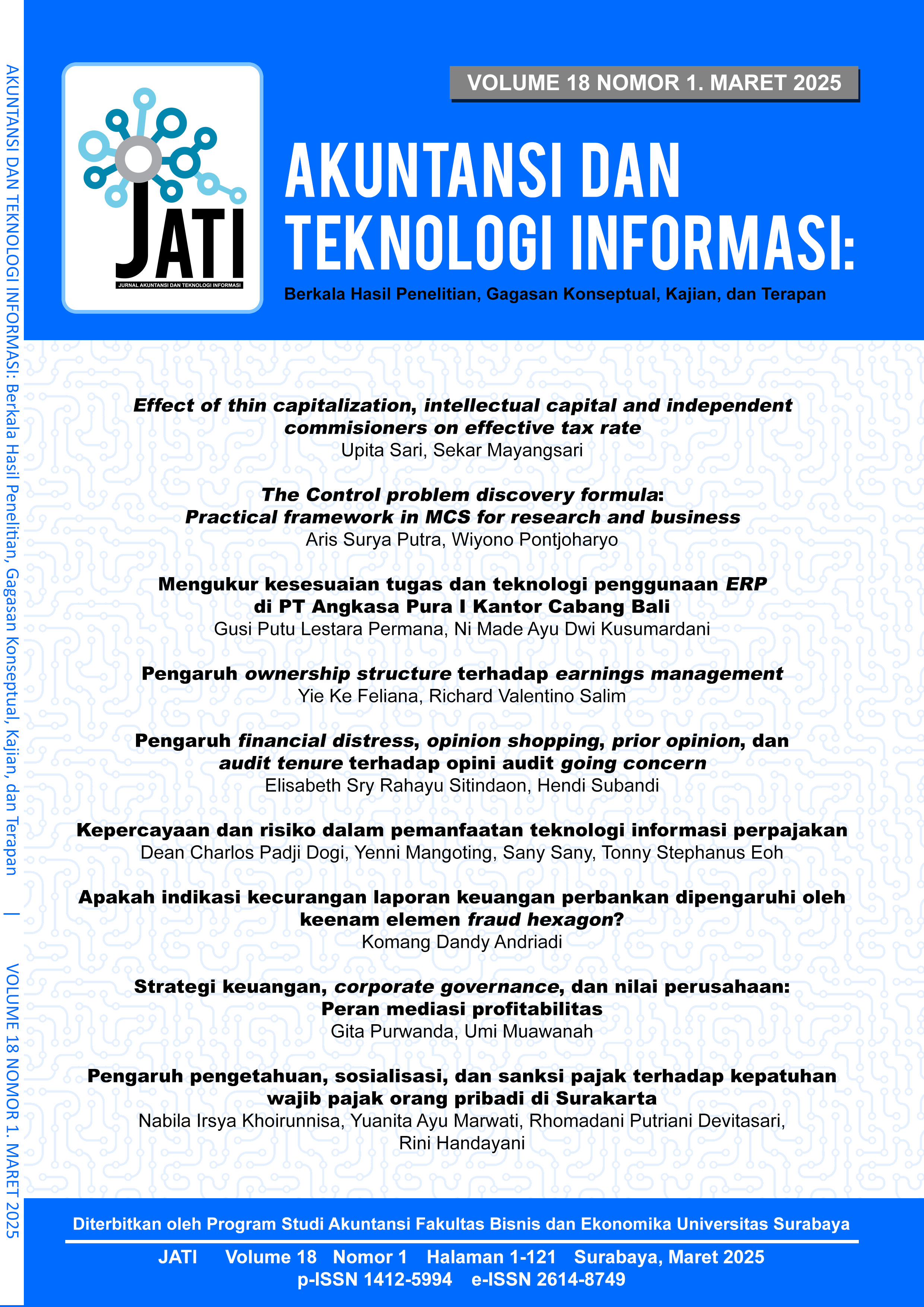Kepercayaan dan risiko dalam pemanfaatan teknologi informasi perpajakan
 Abstract Views:
404 times
Abstract Views:
404 times
 PDF Downloads:
436 times
PDF Downloads:
436 times
Abstract
Purpose – This study evaluates the impact of risk and trust on taxpayers' attitudes and intentions regarding tax information technology. As digital transformation in the tax system continues to evolve, understanding the psychological factors influencing technology adoption is crucial for tax authorities.
Methods – This study employs a quantitative approach using a survey involving 202 individual taxpayers. Data analysis uses the Structural Equation Modeling-Partial Least Squares (SEM-PLS) method to examine the relationships between variables in the research model.
Findings - he results indicate that trust and risk significantly influence taxpayers' attitudes but do not directly impact their intention to use tax information technology. Trust emerges as the most dominant factor in shaping a positive attitude, whereas technological risk plays a greater role in determining negative attitudes. Attitude is found to mediate the effect of trust and risk on the intention to use tax technology.
Implications - This study offers strategic guidance for tax authorities on managing technological risks and enhancing trust. By providing this guidance, the study aims to empower tax authorities in supporting digital transformation in the tax sector.
Originality - This study brings to light the crucial role of attitude as the key mediator in the relationship between trust, risk, and intention to use tax information technology. This aspect, which has received limited attention in previous research, is a unique and significant contribution of this study.
Downloads
References
AbdulKareem, A. K., & Oladimeji, K. A. (2024). Cultivating the digital citizen: trust, digital literacy and e-government adoption. Transforming Government: People, Process and Policy, 18(2), 270–286. https://doi.org/10.1108/TG-11-2023-0196
Ajzen, I. (1985). From Intentions to Actions: A Theory of Planned Behavior. In Action Control (pp. 11–39). Springer Berlin Heidelberg. https://doi.org/10.1007/978-3-642-69746-3_2
Al-Okaily, M. (2024). Attitudes toward the adoption of accounting analytics technology in the digital transformation landscape. Journal of Accounting & Organizational Change.
Alomari, M., Woods, P., & Sandhu, K. (2012). Predictors for e‐government adoption in Jordan: Deployment of an empirical evaluation based on a citizen‐centric approach. Information Technology & People, 25(2), 207–234.
Alzahrani, L., Al-Karaghouli, W., & Weerakkody, V. (2018). Investigating the impact of citizens’ trust toward the successful adoption of e-government: A multigroup analysis of gender, age, and internet experience. Information Systems Management, 35(2), 124–146. https://doi.org/10.1080/10580530.2018.1440730
Brous, P., Janssen, M., & Herder, P. (2020). The dual effects of the Internet of Things (IoT): A systematic review of the benefits and risks of IoT adoption by organizations. International Journal of Information Management, 51, 101952. https://doi.org/10.1016/j.ijinfomgt.2019.05.008
Chauhan, S., & Jaiswal, M. (2016). Determinants of acceptance of ERP software training in business schools: Empirical investigation using UTAUT model. The International Journal of Management Education, 14(3), 248–262.
Davis, F. D., Bagozzi, R. P., & Warshaw, P. R. (1989a). User acceptance of computer technology: A comparison of two theoretical models. Management Science, 35(8), 982–1003.
Davis, F. D., Bagozzi, R. P., & Warshaw, P. R. (1989b). User Acceptance of Computer Technology: A Comparison of Two Theoretical Models. Management Science, 35(8), 982–1003. https://doi.org/10.1287/mnsc.35.8.982
ElSayad, G. (2024). Online customers’ attitudes and intentions towards e-payment usage in Egypt during the COVID-19 pandemic: the serial mediation roles of perceived usefulness, perceived trust, and attitude. Journal of Science and Technology Policy Management. https://doi.org/10.1108/JSTPM-02-2023-0024
Gefen, Karahanna, & Straub. (2003). Trust and TAM in Online Shopping: An Integrated Model. MIS Quarterly, 27(1), 51. https://doi.org/10.2307/30036519
Jayashankar, P., Nilakanta, S., Johnston, W. J., Gill, P., & Burres, R. (2018). IoT adoption in agriculture: the role of trust, perceived value and risk. Journal of Business & Industrial Marketing, 33(6), 804–821. https://doi.org/10.1108/JBIM-01-2018-0023
Mangoting, Y., Pangestu, C. A., Tjan, F. M., & Evangelina, J. G. (2021). Tax Fraud Intentions with an Integrative Model Approach. Petra Christian University.
Mensah, I. K., & Adams, S. (2020). A Comparative Analysis of the Impact of Political Trust on the Adoption of E-Government Services. International Journal of Public Administration, 43(8), 682–696. https://doi.org/10.1080/01900692.2019.1645687
Night, S., & Bananuka, J. (2019). The mediating role of adoption of an electronic tax system in the relationship between attitude towards electronic tax system and tax compliance. Journal of Economics, Finance and Administrative Science, 25(49), 73–88. https://doi.org/10.1108/JEFAS-07-2018-0066
Ögel, S., & Ögel, İ. Y. (2021). The interaction between perceived risk, attitude, and intention to use: an empirical study on bitcoin as a crypto currency. In New challenges for future sustainability and wellbeing (pp. 211–241). Emerald Publishing Limited. https://doi.org/doi.org/10.2139/ssrn.3629292
Pavlou, P. A. (2003). Consumer Acceptance of Electronic Commerce: Integrating Trust and Risk with the Technology Acceptance Model. International Journal of Electronic Commerce, 7(3), 101–134. https://doi.org/10.1080/10864415.2003.11044275
Ramdhani, D., Tamima, Z. A., Yanti, Y., & Effendi, B. (2022). Pengaruh Sikap Wajib Pajak Pada Sistem Pajak dan Sosialisasi Perpajakan Terhadap Kepatuhan Wajib Pajak Orang Pribadi Dengan Adopsi Sistem Pajak Elektronik Sebagai Variabel Mediasi Pada KPP Pratama Cilegon. STATERA: Jurnal Akuntansi Dan Keuangan, 4(1), 37–58. https://doi.org/10.33510/statera.2022.4.1.37-58
Salloum, S. A., & Al-Emran, M. (2018). Factors affecting the adoption of E-payment systems by university students: Extending the TAM with trust. International Journal of Electronic Business, 14(4), 371–390.
Saunders, M., Lewis, P., & Thornhill, A. (2003). Research methods forbusiness students. Essex: Prentice Hall: Financial Times.
Tiwari, A., Kumar, A., Kant, R., & Jaiswal, D. (2024). Impact of fashion influencers on consumers’ purchase intentions: theory of planned behaviour and mediation of attitude. Journal of Fashion Marketing and Management: An International Journal, 28(2), 209–225. https://doi.org/10.1108/JFMM-11-2022-0253

This work is licensed under a Creative Commons Attribution-ShareAlike 4.0 International License.
- Copyright on articles is retained by the respective author(s), without restrictions. A non-exclusive license is granted to Akuntansi dan Teknologi Informasi (JATI) to publish the article and identify itself as its original publisher, along with the commercial right to include the article in a hardcopy issue for sale to libraries and individuals.
- Articles published in Akuntansi dan Teknologi Informasi (JATI) are licensed under a Creative Commons Attribution-ShareAlike 4.0 International license. You are free to copy, transform, or redistribute articles for any lawful purpose in any medium, provided you give appropriate credit to the original author(s) and the journal, link to the license, indicate if changes were made, and redistribute any derivative work under the same license.
- By publishing in Akuntansi dan Teknologi Informasi (JATI), authors grant any third party the right to use their article to the extent provided by the Creative Commons Attribution-ShareAlike 4.0 International license.

 DOI:
DOI:









